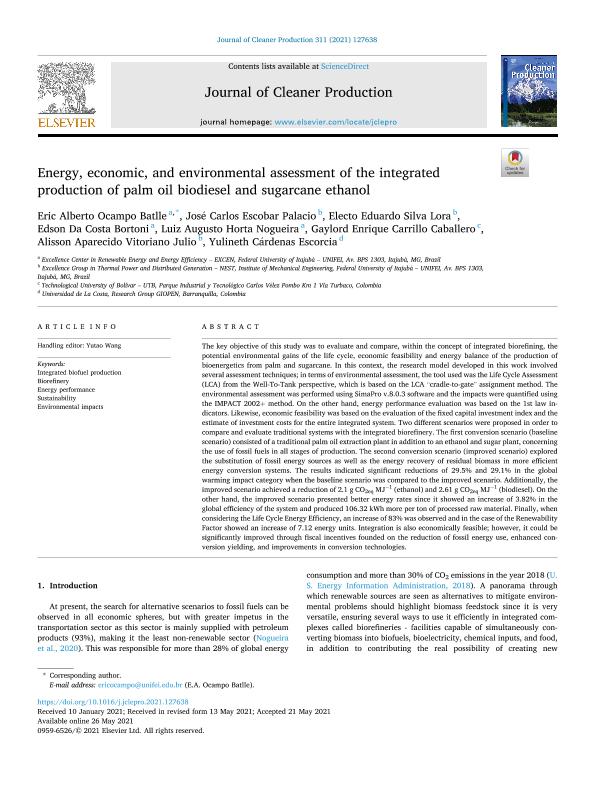Energy, economic, and environmental assessment of the integrated production of palm oil biodiesel and sugarcane ethanol
Date
2021-05-26Author
Ocampo Batlle, Eric Alberto
Escobar Palacio, José Carlos
Silva Lora, Electo Eduardo
Da Costa Bortoni, Edson
Horta Nogueira, Luiz Augusto
Carrillo Caballero, Gaylord Enrique
Aparecido Vitoriano Julio, Alisson
Cárdenas Escorcia, Yulineth
Metadata
Show full item recordAbstract
The key objective of this study was to evaluate and compare, within the concept of integrated biorefining, the
potential environmental gains of the life cycle, economic feasibility and energy balance of the production of
bioenergetics from palm and sugarcane. In this context, the research model developed in this work involved
several assessment techniques; in terms of environmental assessment, the tool used was the Life Cycle Assessment
(LCA) from the Well-To-Tank perspective, which is based on the LCA “cradle-to-gate” assignment method. The
environmental assessment was performed using SimaPro v.8.0.3 software and the impacts were quantified using
the IMPACT 2002+ method. On the other hand, energy performance evaluation was based on the 1st law indicators. Likewise, economic feasibility was based on the evaluation of the fixed capital investment index and the
estimate of investment costs for the entire integrated system. Two different scenarios were proposed in order to
compare and evaluate traditional systems with the integrated biorefinery. The first conversion scenario (baseline
scenario) consisted of a traditional palm oil extraction plant in addition to an ethanol and sugar plant, concerning
the use of fossil fuels in all stages of production. The second conversion scenario (improved scenario) explored
the substitution of fossil energy sources as well as the energy recovery of residual biomass in more efficient
energy conversion systems. The results indicated significant reductions of 29.5% and 29.1% in the global
warming impact category when the baseline scenario was compared to the improved scenario. Additionally, the
improved scenario achieved a reduction of 2.1 g CO2eq MJ− 1 (ethanol) and 2.61 g CO2eq MJ− 1 (biodiesel). On the
other hand, the improved scenario presented better energy rates since it showed an increase of 3.82% in the
global efficiency of the system and produced 106.32 kWh more per ton of processed raw material. Finally, when
considering the Life Cycle Energy Efficiency, an increase of 83% was observed and in the case of the Renewability
Factor showed an increase of 7.12 energy units. Integration is also economically feasible; however, it could be
significantly improved through fiscal incentives founded on the reduction of fossil energy use, enhanced conversion yielding, and improvements in conversion technologies.
Citar como
Eric Alberto Ocampo Batlle, Jose Carlos Escobar Palacio , Electo Eduardo Silva Lora , Edson Da Costa Bortoni , Luiz Augusto Horta Nogueira , Gaylord Enrique Carrillo Caballero , Alisson Aparecido Vitoriano Julio , Yulineth Cardenas Escorcia. Energy, economic, and environmental assessment of the integrated production of palm oil biodiesel and sugarcane etanol. Journal of Cleaner Production. Volume 311, 15 August 2021, 127638. j.jclepro.2021.127638Collections
- Productos de investigación [1453]
Compatible para recolección con:

Archivos
The following license files are associated with this item:
Universidad Tecnológica de Bolívar - 2017 Institución de Educación Superior sujeta a inspección y vigilancia por el Ministerio de Educación Nacional. Resolución No 961 del 26 de octubre de 1970 a través de la cual la Gobernación de Bolívar otorga la Personería Jurídica a la Universidad Tecnológica de Bolívar.













